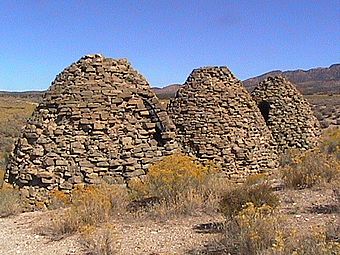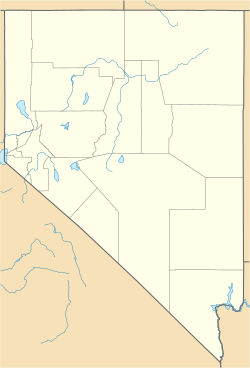Bristol Wells Town Site facts for kids
Quick facts for kids |
|
|
Bristol Wells Town Site
|
|

Old charcoal kilns at the site
|
|
| Location | Lincoln County, Nevada |
|---|---|
| Nearest city | Pioche, Nevada |
| Built | 1870 |
| NRHP reference No. | 72000765 |
| Added to NRHP | March 24, 1972 |
Bristol Wells is a fascinating ghost town in Lincoln County, Nevada. It was once a busy mining town. You might also hear it called National City, Bristol City, or Tempest. This historic site is located on the west side of Bristol Mountain. It's about 14 miles (23 km) northwest of Pioche, Nevada.
Contents
What is a Ghost Town?
A ghost town is a place that was once a lively community. But over time, most or all of its people left. This often happens when the main reason for the town's existence disappears. For Bristol Wells, that reason was mining. When the mines stopped producing enough valuable minerals, people moved away.
The Story of Bristol Wells
Bristol Wells has a rich history tied to mining. It started as a small settlement and grew into a busy town.
Early Mining Days
The first mining claims in the area were made in 1870. This means people found valuable minerals and claimed the land to dig for them. A year later, in 1871, the mining district was officially set up. A small town called National City began to grow around the National Mine.
In 1872, a special furnace was built. This furnace was used to process silver and lead ore from the Bristol Mine. This mine was located about 4 miles (6.4 km) to the east.
The Mining Boom
Things really picked up in 1878. A much richer deposit of minerals was discovered! This led to the building of a stamp mill. A stamp mill uses heavy stamps to crush ore. This helps separate the valuable metals. The settlement was renamed Bristol City that same year.
The stamp mill got even bigger in 1880. A smelter was also built. A smelter uses heat to extract metal from ore. To fuel the smelter, stone ovens were built to make charcoal. The town's wells provided important water for all the mining operations. By 1890, a new smelter was built to process copper ore. At its peak, the town's population reached about 400 people.
Decline and Later Years
After 1893, mining activity started to slow down. In 1900, a special plant was built to recover copper using a method called leach-recovery. This plant worked for two years.
In 1913, an aerial tramway was constructed. This was like a cable car system for moving ore. It stretched about 2 miles (3.2 km) to Jackrabbit, Nevada. From Jackrabbit, the ore could be loaded onto the Los Angeles and Salt Lake Railroad. This made it easier to transport the minerals.
Mining continued off and on, but it sharply declined after 1918. The town was briefly renamed Tempest in 1922, after the Tempest Mine. But it went back to being called Bristol in 1929. The local post office stayed open until 1950. After that, the town became a true ghost town.
A Historic Site
Today, the Bristol Wells townsite is recognized for its history. It was officially listed on the National Register of Historic Places in 1972. This helps protect the remains of the old town. It reminds us of Nevada's exciting mining past.



